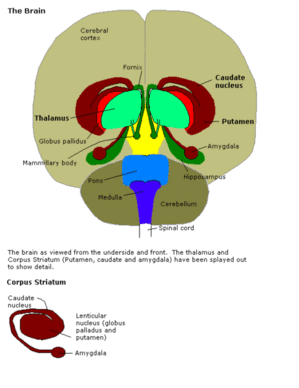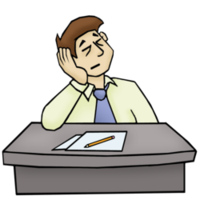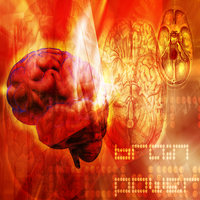Breathing Problems During Sleep and the Heart

We have talked about the importance of heart rate variability (HRV), which reflects the activity of many critical bodily functions. HRV is the result of a subtle interplay between the heart and the nervous system, and abnormalities in HRV may be an early warning of severe illness and even of death.
There are many reasons why peoples’ breathing can become disturbed during the night, and it is essential to be sure that we are treating the right thing.
In obstructive sleep apnea (OSA) the body stops breathing during sleep. The most common reason for OSA is swelling of the tissues at the back of the throat that then block the airway.
In central sleep apnea (CSA) is a breathing decreases or stops during sleep. It may occur as a result of a problem in the sleep centers in the brain, and/or the nerves supplying the heart. It usually follows a cycle, with people breathing normally for a while and then slowing or stopping altogether.
Continuous positive airway pressure (CPAP) that provides a steady stream of pressurized air is often the best treatment for sleep apnea.
There is a close relationship between breathing and the heart, and new research from the Alfred Hospital and Monash University in Melbourne, Australia has looked at a sleep-related breathing disorder that is common in heart failure, and increases HRV.
The researchers looked at the breathing patterns of 21 patients with heart failure who had sleep-related breathing disorder.
They found that as people transitioned from stable breathing to a sleep-related breathing disorder, there was an associated increase in HRV.
On the other hand, people with central sleep apnea (CSA) and obstructive sleep apnea (OSA) produce different patterns of HRV, suggesting that they each involve different mechanisms in the heart and the brain.
This may sound esoteric, but it is not.
Breathing problems during sleep are common and so is heart failure. Unfortunately heart failure carries a high mortality rate, and it is very valuable to have simple tests to guide us to give the correct treatment.
Simply measuring HRV during sleep will give us an idea about whether or not a person with heart failure is stable, or if we need to change treatments before he or she starts getting symptoms.
“All the energy that is used in the creation of every cell in the universe is on that breath that you are breathing in.”
–George King (English Spiritual Teacher, Writer and Founder of the Aetherius Society, 1919-1997)
“For breath is life, and if you breathe well you will live long on earth.”
–Sanskrit Proverb
“There is one human activity which is continuous, rhythmic, natural, easy, and pleasant. It is breathing. We may take advantage of its existence by combining it with a simple exercise to bring about a kind of meditation which will possess all these four mentioned attributes. The exercise is merely to repeat one word silently on the inhalation and another word on the exhalation. The two words must be such that they join together to make a suitable spiritual phrase or name. Here is one useful example: “God Is.”
–Paul Brunton (a.k.a. Raphael Hurst, English Philosopher, Traveler, Spiritual Teacher and Author, 1898-1981)
“You know that our breathing is the inhaling and exhaling of air. The organ that serves for this is the lungs that lie round the heart, so that the air passing through them thereby envelops the heart. Thus breathing is a natural way to the heart. And so, having collected your mind within you, lead it into the channel of breathing through which air reaches the heart and, together with this inhaled air, force your mind to descend into the heart and to remain there.”
— Nicephorus the Solitary (Calabrian Christian Mystic and Monk on Mount Athos, c.1250-1300)
Sleep Deprivation and Emotional Instability

Most of the time we are in control of our moods, rather than our moods being in control of us. One of the main things that we learn as we get older is not simply to damp down our emotional reactions, but to make them “contextually relevant:” we produce the right emotional response for the right situation. Yet we also know that there are exceptions: times when our emotions over-run any attempts at our control.
Second, we all know that sleep deprivation can be a Bad Thing. It is known to impair a range of mental and physical activities, including immune function, metabolic control and many cognitive processes, including learning and memory.
It has long been suspected that sleep deprivation can have significant effect on mood. Many of us feel irritable and distractible if we haven’t slept enough, and you may have had the experience of being up all night and feeling a little bit “high” in the morning. It has also been known for centuries that mood disorders are very commonly associated with sleep disturbances, and sleep disturbance is often the first sign that someone with mood problems is running into trouble. So mood and sleep must be linked in some way.
Despite these common observations, there has never been that much empirical evidence for the impact of sleep deprivation on mood, and in particular the effects of sleep deprivation on the brain.
An important new study by researchers from Harvard Medical School and the University of California at Berkeley has just been published in the journal Current Biology, and it is beginning to fill in some of the gaps in our knowledge.
The amygdala is known to be involved in processing of emotionally salient information, particularly unpleasant or aversive stimuli. In mature individuals, the emotional centers of the brain are usually controlled and modulated by an array of connected systems, mainly in the frontal regions of the brain. One particularly important part of the frontal lobes that is involved in controlling the amygdala is the medial-prefrontal cortex (MPFC). Under normal conditions the MPFC is supposed to exert an inhibitory, top-down control of the amygdala, so that we only generate appropriate emotional responses.

The scientists worked with 35 volunteers who were deprived of sleep for 35 hours. Blood flow can be used to deduce which specific regions of the brain are active. The researchers used functional magnetic resonance imaging (fMRI) to examine the blood flow – and therefore activity – in the brains of the volunteers in real time, both during and after sleep deprivation.
After going without sleep, the participants were asked to look at images that were designed to trigger angry or sad emotional responses. The investigators discovered that the amygdala showed 60% higher reactions to the images compared with people who are not sleep-deprived.
This is an extraordinarily large effect and implies that sleep deprivation knocks out the normal control mechanisms in the frontal lobes so that the sleep-deprived brain reverts to a more primitive pattern of activity. As a result we become unable to put emotional experiences into context and produce controlled, appropriate responses.
If we needed any more reasons to get a good night’s sleep, this one is very powerful. It also re-iterates something very important: if you or a loved one have had problems with mood, anger or anxiety, it is essential to watch your sleep pattern. Any change may be a harbinger or trouble, and is an excellent early warning that you or they need a hand to make sure that things stay on an even keel.
“Your brain shall be your servant instead of your master, you will rule it instead of allowing it to rule you.”
–Charles E. Popplestone (American Author of Every Man a Winner, 1936)
“Control your emotions or they will control you”
–Chinese Proverb
“For the uncontrolled there is no wisdom, nor for the uncontrolled is there the power of concentration; and for him without concentration there is no peace. And for the unpeaceful, how can there be happiness?”
–Bhagavad Gita (Ancient and Sacred Sanskrit Poem Incorporated into the Mahabharata)
“He who controls others may be powerful, but he who has mastered himself is mightier still.”
–Lao Tzu (Obscure Chinese Philosopher, Founder of Taoism and Alleged Author of the Tao-Te Ching, c. 604-c. 531 B.C.E.)
“ . . . let every man be swift to hear, slow to speak, slow to wrath.”
–The Bible, James 1:19
“When angry, count ten before you speak; if very angry, a hundred.”
–Thomas Jefferson (American Writer, Philosopher, Politician and, from 1801-1809, 3rd President of the United States, 1743-1826)
Mother’s Dreams

Having a baby is one of the Really Big events in life, and it is no surprise that both pregnancy and birth have a major influence on the structure and content of a mother’s dreams.
It is also not surprising that many of the dreams have a strong negative component to do with maternal responsibility, or depicting the new infant in dreamed situations of danger. These dreams can cause anxiety that can spill over into wakefulness. A new study from Montreal published in the journal Sleep has added something new: these kinds of dreams may be accompanied by complex sleep behaviors such as motor activity, speaking and expressing emotions.
The study from the Sleep Research Centre at the Hôpital du Sacré-Coeur de Montréal in Montréal, Québec, Canada, focused on 273 women, who were divided into three groups: postpartum, pregnant, and women who had not given birth. The subjects completed questionnaires about pregnancy and birth factors, personality and sleep. They were also interviewed and asked about the prevalence of recent infant dreams and nightmares, associated behaviors, anxiety, depression and other psychopathologic factors.
- The percentage of women in all groups who recalled dreams ranged from 88-91%
- Postpartum and pregnant women recalled infant dreams and nightmares with equal prevalence, but more postpartum women reported they contained anxiety (75%) and the infant in danger (73%) than did pregnant women (59%)
- Motor activity was present in twice as many postpartum (57%) as pregnant (24%) or non-pregnant (25%) women
- Expressing emotion was more prevalent among women without children (56%) than postpartum women (27%), but was not different from pregnant women (37%)
- Speaking while asleep was equal among the three groups (12-19%)
- Behaviors were associated with nightmares, dream anxiety and, among postpartum women, post-awakening anxiety (41%), confusion (51%), and a need to check on the infant (60%)
Most pregnant women experience daytime fatigue primarily because the quality of their sleep tends to be worse. Physical discomfort and awakenings are common, particularly during the third trimester.
Snoring often increases during pregnancy and obstructive sleep apnea may develop as the pregnancy progresses.
Two other sleep disorders that are more common during pregnancy are restless legs syndrome (RLS) and sleep related leg cramps. RLS affects nearly 25% of pregnant women and may be related to low iron stores. Leg cramps occur in about 40% of pregnant women, although they usually clear up after delivery. They tend to go away after delivery.
It is easy to understand these dreams from an evolutionary perspective. Though there is also a small literature on mothers who get intuitive flashes about their distressed infants. I have followed this work for many years. When I was an infant I chocked on a banana, and my mother who was some way off “saw” it happening in her mind’s eye and rushed in to find a very small RP who had already turned blue. She swore to her dying day that the tale was true.
And I still cannot eat bananas.
Sleep and Your Heart

The amount of sleep a person gets affects his or her physical health, emotional well-being, mental abilities, productivity and performance. Recent studies associate lack of sleep with serious health problems such as an increased risk of depression, obesity, cardiovascular disease and diabetes.
There was some interesting research presented at SLEEP 2007, the 21st Annual Meeting of the Associated Professional Sleep Societies in Minneapolis in the middle of June.
One study that caught my eye was conducted by Siobhan Banks of the University of Pennsylvania School of Medicine. The research was based on preliminary analysis of 39 subjects, each of whom participated in a laboratory-controlled chronic sleep restriction protocol. The subjects underwent two nights of baseline sleep followed by five hours of sleep restriction. The results showed a statistically significant decrease in the heart rate variability after just five nights of sleep restriction.
We already know that a reduction in heart rate variability may occur in several cardiological and non-cardiological diseases, and it is usually a harbinger of a poor outcome.
This work may provide the mechanism for why short sleep duration is associated with a heightened risk of heart and other circulatory problems.
The amount of sleep a person gets affects his or her physical health, emotional well-being, mental abilities, productivity and performance. Recent studies associate lack of sleep with serious health problems such as an increased risk of depression, obesity, cardiovascular disease and diabetes.
So if confirmed, the take home message is that sleep deprivation has a negative effect on a person’s cardiac activity and that may in turn increase the risk of cardiovascular disease and mortality.
Fibromyalgia is Real! A Battle That Should Not Have To Be Fought Again

Fibromyalgia is a chronic, widespread pain in muscles and soft tissues accompanied by fatigue, it is a fairly common condition, affecting 3% to 6% of the general population, and is most commonly diagnosed in people between the ages of 20 and 50, though onset can occur in
childhood. The disease is not life-threatening, though the degree of
symptoms may vary greatly from day to day with periods of flares
(severe worsening of symptoms) or remission. The syndrome is generally
perceived as non-progressive, yet that issue is still a matter of debate.
The cardinal symptoms of fibromyalgia are chronic, widespread pain and
tenderness to light touch together with moderate to severe fatigue.
Those affected may also experience heightened sensitivity of the skin (“allodynia“),
tingling of the skin that is often needle-like, a deep ache in the muscle and , less often, the tendons, prolonged muscle spasms, weakness in the limbs, and nerve pain.
Chronic sleep disturbances are also characteristic of fibromyalgia, and
some studies suggest that these sleep disturbances are the result of a
sleep disorder called alpha-delta sleep , a condition in which
deep sleep (associated with delta EEG waves) is frequently interrupted
by bursts of brain activity similar to wakefulness (i.e. alpha waves).
Deeper stages of sleep (stages 3 & 4) are often dramatically
reduced, and that is the likely cause of the cognitive problems that so often accompany fibromyalgia.
There is not any structural damage in an organ, though it may sometimes start after trauma, such as a motor vehicle accident.
It is that last fact, that there is s often no obvious physical pathology, that has lead so many people to claim that fibromyalgia is “nothing more than” pain associated with depression. I have has some interesting “discussions” with health care professionals convinced that people wit fibromyalgia do not have a “real” illness, and that they need psychotherapy or antidepressants. Yet pain is pain, and the false dichotomy: “Is the pain my mind or in my body?” helps nobody.
Twenty-five years ago, Muhammad B. Yunus and his collaborators published the first controlled study of the clinical characteristics of fibromyalgia syndrome. That seminal article, published in Seminars in Arthritis and Rheumatism, led directly to formal recognition of this disease by the medical community. Last month, again in Seminars in Arthritis and Rheumatism, Muhammed makes another enormous contribution to the field of chronic pain and fatigue by meticulously synthesizing and interpreting the extensive body of scientific literature on fibromyalgia and his own insights into the concept of central sensitivity syndromes (CSS) that include irritable bowel syndrome, migraine and restless legs syndrome.
In fact there are at least 13 separate conditions that are related to central sensitization (CS), where the central nervous system becomes extremely sensitized with respect to certain parts of the body, so that even mild pressure or touch would cause much pain. This hypersensitivity may also be associated with other symptoms such as poor sleep and fatigue.
Muhammed took a rather more biological approach to fibromyalgia in the past, now emphasizes a biopsychosocial perspective:
“In my view, this is tremendously important because it is the only way to synthesize the disparate contributions of such variables as genes and adverse childhood experiences, life stress and distress, posttraumatic stress disorder, mood disorders, self-efficacy for pain control, catastrophizing, coping style, and social support into the evolving picture of central nervous system dysfunction vis-à-vis chronic pain and fatigue. Science and medicine now have rational scaffolding for understanding and treating chronic pain syndromes previously considered to be ‘functional’ or ‘unexplained.’ Neuroscience research will continue to reveal the mechanisms of CS, but only if informed through a biopsychosocial perspective and with the interdisciplinary collaboration of basic scientists, psychologists, sociologists, epidemiologists, and clinicians.”
One of the reasons that I so like this new version of his model is because it fits so well with the concept of “Salience Disruption Syndrome.” A fancy name for a common problem that I talk about in Healing, Meaning and Purpose.
So very many people are super-sensitive to the environment and also have trouble in filtering out and deciding what is important. As a result pain, attentional problems, impulse control disorders, addictions and several other things tend to cluster together.
Happily we now have an array of novel techniques for dealing with these problems, and I plan to put out more books and papers on ways in which we can help.
Aggressive Bullies, Sleep and Breathing
Here is yet another possible problem associated with poor quality sleep and breathing problems during sleep.
Research from the University of Michigan that was presented at SLEEP 2007, the 21st Annual Meeting of the Associated Professional Sleep Societies in Minneapolis this week, suggests a link with aggression.
Aggressive behavior and bullying are common amongst schoolchildren and are likely to have multiple causes. But a new one, and one which may be an undiagnosed, is sleep-related breathing disorder (SRBD).
The study focused on children in the second through fifth grades who attended school in an urban public school district. Parents completed two well-validated rating instruments: the Conners’ Parent Rating ScalePediatric Sleep Questionnaire SDB Scale. Teachers completed the Conners’ Teacher Rating Scale (CPRS) the (CTRS). The numbers of discipline referrals in the previous 12 months were obtained from the six elementary schools.
A total of 345 CPRS’s and 245 corresponding CTRS’s were completed. The main finding was that schoolchildren who bully may be more likely to have an SRBD than their peers.
An SRBD may be a problem in more than 10 percent of children. It occurs when the airway is partially blocked during sleep. The most common example is snoring. The most severe form of an SRBD is obstructive sleep apnea. It occurs in about one percent to two percent of children.
If you suspect that your child or grandchild might be suffering from an SRBD or, for that matter, any type of sleep disorder, it is a really good idea to consult with your child’s pediatrician, who can see of he or she needs to be referred to a sleep specialist.
We already know that treatment of an SRBD may improve other mood, attention and behaviors in
children. We do not know if treatment might reduce aggression and bullying, and that will be the next research project.
Sleep Deprivation

When I was a young doctor we used to work absurdly long hours: for more than three years I worked every other night and every other weekend. It was not uncommon to be on your feet for three at a time. It is a wonder that we didn’t die or make more mistakes.
We know that sleep deprivation is not healthy, but we are only now beginning to find out just how damaging it can be. One of the biggest problems is that sleep deprivation interferes with the normal functioning of the immune system.
I saw an interesting paper (NR619) at the 2007 Annual Meeting of the American Psychiatric Association in San Diego last month.
A team from Korea took sixteen healthy volunteers and made them stay awake for 48 hours. They found that even this relatively short period of sleep deprivation produced some impressive effects on the body and the mind:
- Thyroid hormone levels rose
- The speed and accuracy of reaction times fell
- Blood glucose and protein levels rose, and there were disturbances in several liver function tests
- White blood counts increased
- There was a slight fall in immunoglobulin levels
We already know that insufficient sleep is associated with insulin resistance and weight gain, and it is likely that these are mediated by a rise in inflammatory mediators in the blood.
It is remarkable how quickly the effects occur.
And how pleased I am that young doctors no longer have to tolerate those incredibly long shifts.
Some things have changed for the better!
Larks, Owls and Depression

It is well known that mood disorders are associated with the disruption of many of the circadian rhythms of the body including sleep, temperature and thyroid function. These links are so well known that many experts believe that depression may be a consequence of disturbances in circadian rhythms.
Although circadian rhythms tend to be fairly consistent across individuals, but there are significant differences in these rhythms in different people: we call this the “morningness-eveningness” dimension (MED).
As part of a larger project, researchers from Providence, Rhode Island last month presented a most interesting study (NR293) at the 2007 Annual Meeting of the American Psychiatric Association in San Diego.
People with psychiatric problems tend to be owls: evening types who don’t like mornings, and this was particularly striking in people with depression.
This suggests that “eveningness” may be reflecting a risk factor or vulnerability to psychopathology, in particular depression. It may actually be that if you are a “morning person,” you may have some protection against developing depression.
I remember seeing a study from Stanford in April that suggested that people labeled a “night owls” report more pathological symptoms related to insomnia, despite many having the opportunity to compensate for their nocturnal sleeplessness by extending their time in bed and being able to gain more total sleep time. So this may be the link with depression.
Non-pharmacological and Lifestyle Approaches to Attention-Deficit/Hyperactivity Disorder: 5. Exercise, Environment and Sleep

One of the most valuable things to do to help children or adults with ADHD is to help them to structure their time.
All the approaches that we have already discussed, from medications to diets, herbs and homeopathy are all tools designed to help people get to the point where they can create, accept and maintain more structure in their lives. Exercise, the environment and regular sleep are all essential contributors.
Exercise
Aerobic exercise may be particularly helpful for people who also have a mood disorder or anxiety probably by reducing inflammatory mediators in the blood.
There is a movement therapy called eurythmy that was developed by Rudolf Steiner. It is quite popular in central Europe, and there has been a report that it could help children with ADHD.
Environment
There is evidence that children with ADHD do better if they are outside, and even being a green room seems to help them.
There are plenty of anecdotes about children and some adults with ADHD improving if they have classical or New Age music in the background. Paradoxically some like and claim benefit from “heavy metal.” There is recent evidence from New Zealand indicating that music therapy may contribute to the reduction of a range of ADHD symptoms in adolescents, as it does in younger children. With the advent of the iPod, it is easy to make a playlist of music that helps attention and concentration.
The data on the effect of watching television, computer time or playing video games is a mixed bag. There are people who say that children under the age of three should not watch television at all, and the American Academy of Pediatrics recommends that children under the age of 2 years should watch no television, and that television time should be limited to less than 2 hours daily in older children. The research data has not produced a clear answer one way or the other. Some of the most recent research does suggest a link between the amount of time that children spend
watching television and attention-deficit/hyperactivity disorder, but
it remains unclear as to whether elevated levels of television viewing
are the cause or result of ADHD symptoms. Other researchers have failed to find a connection. The best thing is to play safe and to keep television viewing to a minimum: there are so many other things for a child to be doing.
There have been questions about whether other environmental factors, particularly lead, mold and Candida could cause ADHD.
Lead toxicity is well-known to cause neurological problems, but studies of a link between lead levels and ADHD have usually failed to find a link, and in a study in which children with minimally elevated lead levels were given a drug – penicillamine – to remove lead, there was no change in ADHD rating scores. So it is unlikely that lead is a factor in most children.
Because of the high rates of allergies in people with ADHD, there have been attempts to see if mold or other environmental pollutants could be causing ADHD. So far the data has drawn a blank.
Another environmental factor that has been look at is the yeast Candida albicans. It can produce nasty infections in people with compromised immune systems. But in addition, some people have claimed that Candida infections can cause an array of medical problems, including ADHD-like symptoms. People who are thought to have Candida have been treated with diets as well as the antifungal agent nystatin, with mixed results. It would be good to do a formal study of Candida in ADHD and see if there is a link and if treatment helps. So far we just do not have one.
Sleep
Sleep disturbances are extremely common in ADHD. They often get better once an individual is treated, but it is still a good idea to practice good sleep hygiene.
- Stress management
- Exercise a couple of hours before retiring
- Keeping mentally stimulated until it is time for bed
- Though we want to have a regular bedtime and bedtime ritual, to begin with don’t go to bed until you are tired
- No caffeine, alcohol or nicotine after 6pm. (Preferably, of course, no nicotine ever!!) {Remember that many over the counter painkillers contain caffeine, as does chocolate}
- Try to keep the bedroom atmosphere relaxing, and establish a sleep ritual
- Keep the room quiet and dark
- If you like aromatherapy, lavender and chamomile are usually best
- If you cannot sleep, get up and do something relaxing: struggling to go to sleep is virtually impossible.
- Do not have a television in the bedroom. Bedrooms should be reserved only for sleep in children and for one other activity in adults
- Always get up at the same time in the morning, to try and re-set your brain, and as soon as you get up, be exposed to as much bright light as possible
Stonehenge

One of the most amazing monuments in England is Stonehenge. These days most people cannot enter it, but when I first saw it as a teenager in the early 1970s you could still go inside, and it was one of the places that I was taught to dowse. The power of the place has undoubtedly risen with its fame and mystery, but the fact remains that most sensitive people are quite strongly affected by it.
Some of the stones were probably brought from South Wales and the entire Stonehenge complex was built in several construction phases spanning
about 2,000 years, although there is evidence for activity both before and
afterwards on the site. There was a wooden henge of the site long before the stones arrived.
The BBC is reporting that archaeologists have discovered a huge ancient settlement used by some of the people who built Stonehenge.
Excavations at Durrington Walls have uncovered remains of ancient houses. People seem to have occupied the sites seasonally, using them for ritual feasting and funeral ceremonies.
It is thought that in ancient times, this settlement would have housed hundreds of people, making it the largest Neolithic village ever found in Britain. The dwellings date back to 2,600-2,500 BC – according to the researchers, the same period that Stonehenge was being built or re-built.
Mike Parker Pearson from the University of Sheffield, said, “In what were houses, we have excavated the outlines on the floors of box beds and wooden dressers or cupboards.”
The researchers have excavated eight houses in total at Durrington. But they have identified many other probable dwellings using geophysical surveying equipment. They think there could have been at least one hundred houses, each measuring about 5m (16ft). They are square, made of timber, with a clay floor and central hearth. The archaeologists found 4,600-year-old rubbish covering the floors of the houses.
And archaeologists love rubbish!
The evidence suggest that Stonehenge drew Neolithic people from all over the region, who came for massive feasts in the midwinter where they consumed prodigious quantities of food. The bones were then tossed on the floors of the houses.
Durrington has its own henge made of wood, which is strikingly similar in layout to Stonehenge. It was discovered in 1967.
Both henges line up with events in the astronomical calendar – but not the same ones. Stonehenge is aligned with the midwinter solstice sunset, while Durrington’s timber circle is aligned with the midwinter solstice sunrise. So it would seem that they were complementary.
Stonehenge lies on an extraordinary system of ley lines that crisscross the British Isles, parts of Northern France and parts of China. The lines are usually dismissed as pseudoscience, and it is certainly sometimes difficult to follow what some writers have to say on the subject. There is also a small body of evidence that some people can sense these ley lines. For people who can, the sensation is much the same as feeling the acupuncture meridians of the body. This apparent similarity has lead some experts in Feng Shui to approach personal wellness in the same way that they recommend the placement of plants, mirrors and other objects. Both the body and the land are looked at like gardens that need to be cultivated.
With some people, where they live, how they lie in bed and where they are treated can all be affected by these lines. Others don’t seem to notice a thing. I was once treating a lawyer with insomnia, and things were not going well. Until she went on vacation to England and she was fine for a couple of weeks. On her return to the USA we just moved her bed and the problem was solved. I just wish that it were always that easy!
It took me a long time to be persuaded that what I and others felt at Stonehenge and along these lines was real and not just make believe. But now I am convinced. The Ancients knew something about the relationship of the land to their lives, and we are finally recovering some of that knowledge for ourselves.






